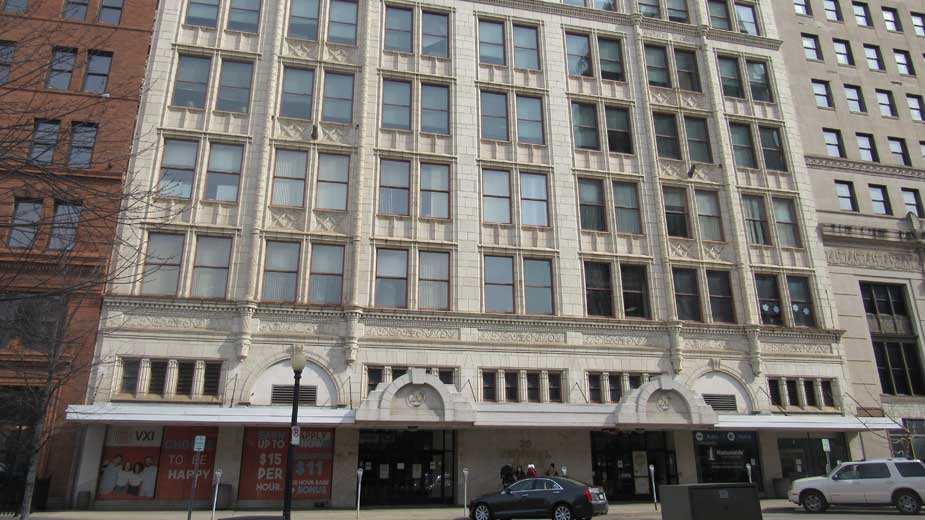Council Committee Gets 20 Federal Update
YOUNGSTOWN, Ohio – Youngstown officials and their partners are eyeing state funds totaling about $30 million to support redevelopment of the city-owned 20 Federal Place, and more with the discovery of other possible sources and the recent creation of new ones.
Representatives of the consultant and designated developer chosen by the city provided an update on the nearly century-old building during a virtual meeting Tuesday of City Council’s community planning and economic development committee.
Last month the city approved a second 60-day extension of its memorandum of understanding with Desmone, the Pittsburgh architectural firm it selected to redevelop the 332,000-square-foot building at 20 W. Federal St. Last December, the firm proposed a redevelopment concept that included a mix of commercial and residential space plus a rooftop restaurant and observation deck.
One reason for the delay was the local partners are awaiting word on whether the city’s $7 million application to the state’s brownfield remediation grant program to fund remediation work in the building will be approved.
In December, the city applied for the funds in partnership with the Mahoning County Land Bank. No Mahoning County projects received funding when the first round of grants was announced in April.
State officials have since informed the local partners that all of the “outstanding questions” that needed to be answered have been and they have everything they need regarding the application, said Jim Ambrose, Desmone’s director of business development.
“So at this point, we are just waiting for that,” he said. Approval of the brownfield funds would represent the first step to unlocking the “entire capital stack,” Ambrose said.
In response to a question from 5th Ward Councilwoman Lauren McNally, he acknowledged that a scenario in which the city doesn’t receive the brownfield grant has not been modeled. He added that state officials he’s in contact with “made us feel fairly confident” about funding, although nothing was guaranteed.
Another reason Desmone sought the MOU extension was the discovery of another layer of capital that was identified at the state level, the transformational mixed-use development tax credit. Qualifying projects have to be greater than 400,000 square feet, and applications for the annual program are due in July, he said.
Additionally, applications for the state historic preservation tax credit are due in September, a program that he acknowledged comes with “a required level of design, engineering and documentation” to be shown to the state. He also reported that the state recently doubled the amount of funds available for the program, and the city could potentially qualify for a double allocation of $8 million because Youngstown is a distressed city and the community is seen as a rural city.
Kyle Miasek, city finance director, said Ambrose shared with him some of the costs associated with preparing the design portion of the application for the historic tax credits. Once those details and costs are shared within the city administration, a meeting will be scheduled with council members to discuss potential next steps, he said.
“Once you qualify for the state historic tax credit, you have access to the federal one. We’re talking about approximately $30 million worth of capital that we would have unlocked dedicated solely for this project,” Ambrose said. Desmone’s “first priority” is to “pursue every single state incentive” to minimize the “local ask,” he said.
Ambrose said a “national institutional capital partner” who toured 20 Federal “was very interested in the project” because of the collaboration among local stakeholders.
“We do believe that this project will come together. It’s just going to be a matter of patience and a matter of unlocking these various funding sources to dedicate to the project and kick start it,” he asserted.
“This is a complicated building that’s a significant structure to the community,” said Doug Rasmussen, CEO and managing principal with Steadfast City Economic & Community Partners, a St. Louis-based consultant working with the city on 20 Federal. “I am of the belief that we really are getting some momentum here.”
Beyond the funding sources the city is pursuing, Ambrose pointed to another recently announced potential funding source, a $500 million fund for Appalachian counties in Ohio.
“I’m sure that application will come out sometime in the next month or so as well,” he said. “The way that we can position this project to be successful is to define collectively how it is a regional transformation.”
First Ward Councilman Julius Oliver, whose ward includes 20 Federal, expressed concerns over lack of communication with the building’s current tenants.
“We definitely want this project to work but I also want to keep as many businesses as I can in the city and downtown,” he said.
Without knowing whether the brownfield grant will be approved, the city has been walking a “fine line of trying not to complicate those people’s businesses and their livelihood,” Miasek said.
“The city wants to remove itself from owning a commercial building. But at the same time it is the major anchor of downtown,” he said. “That’s why prior administrations chose to act and take ownership of it.”
The ultimate goal is to make the project work, McNally said.
“We know the financial burden the building places on the city every year. We don’t want to be a landlord,” she said.
Copyright 2024 The Business Journal, Youngstown, Ohio.



